Why you should visit Oaxaca
I had a hard time writing this post on Oaxaca, maybe because I have contradictory feelings about the city that I still haven’t resolved in my mind. On one hand I love the size of the city, geography, food, and relative tranquility of Oaxaca. And Oaxaca has tons of colorful buildings, impressive churches, as well as some great sites of interest in the surrounding area. There are lots of things I really like about the city. On the other hand I had a hard time with the economic disparities of Oaxaca, little things that – similar to walking around with gum stuck to the heel of your shoe – bothered me just enough for me to say that I don’t love the city. I’ll address that in detail further below.
First, the aspects of Oaxaca I really like:
With a population of less than 300,000, and surrounded by mountains (which I’m told become a lush green when the rains start in May), the city has the feel of a large town rather than a ‘city’. It is tranquil and peaceful, especially on weekdays (weekends get busier with domestic tourists). The exception to this general rule is the zocalo – which gets a lot of the city’s tourist activity – and the markets to the south of the zocalo (Benito Juarez and 20 de Noviembre markets) which are usually bustling.
Santo Domingo church is one of the most impressive churches I’ve seen in Mexico. And this is a country with some incredible churches. But Santo Domingo is special and will make even a hardened Europhile go “ahhh”. It is not just the beautiful, ornate interior, but also the massive exterior design that impresses. Attached to the church, in the former monastery, is the best museum in the city (the ‘Museo de las Culturas de Oaxaca’) containing many artifacts from the tombs of nearby Monte Alban.
Great food: some of the nicest streets as well as the best restaurants in the city are located in the small streets around Santo Domingo church. Around the back of the church, on La constitucion, is a great coffee/croissant place called ‘The Oaxacan Coffee Company”. A block west, on Garcia Vigil, are Biznaga and Zandunga, two excellent restaurants (the atmosphere at Biznaga is great and I would recommend going there just for that).

Excluding the fancier restaurants mentioned above, there are some great cheap eats in Oaxaca. We had a favorite taqueria (pictured below) on the corner of Reforma/Abasolo. Chocolate is a big deal in Oaxaca (it’s even used in their moles) and one of our favorite things to do was ordering a ‘malteado’ at Mayordomo (less than $1 – plus they give out free chocolate samples). Just south of the zocalo we came across the 20 de Noviembre market which is a giant food court where you can order lots of exotic cheap eats. We saw a few travelers in there eating empanadas with what looked like cactus leaves. They seemed to be having a good time. Here is a great post by a fellow blogger on food in Oaxaca. It really is food paradise and I only wish we had had more time to sample more of everything.
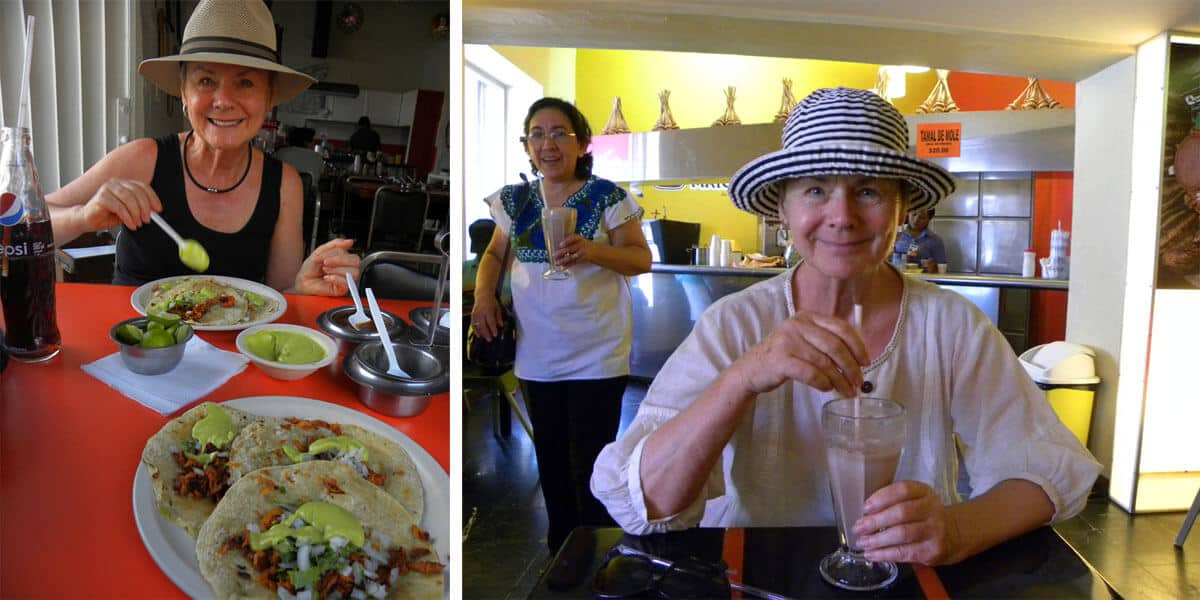
.
The Alcala, the pedestrian-only street connecting the city’s two main squares, has some great colonial buildings along with museums and photo galleries. A pretty half-kilometer walk on what is the most popular (and busiest) street in Oaxaca.
Nearby sites/activities: Oaxaca is small and there are some interesting sites within a manageable distance of the city. The highlight of these (the one you can’t miss if in Oaxaca) is the Archeological site of Monte Alban. In the opposite direction, about 30 minutes from Oaxaca, is Mitla, the second most important archeological site in the state. Many people visit Mitla as part of a bigger tour that includes a visit to the rug makers of Teotitlan del Valle and El Tule Tree (a huge, 2000 year old tree – the largest tree in Latin America). There are other highlights in the area: the Sunday market at Tlacolula (25 minutes away) and the ruins at Yagul and Dainzú (for those who haven’t had their fill of ruins after seeing Monte Alban and Mitla). Further away (an hour and a half) a visit to Hierve el Agua is a favorite among many travelers – there you can see petrified waterfalls and bathe in pools of mineral-rich water (This tour will take you to these sites).
.
A few other things I enjoyed and recommend doing in Oaxaca: Climb up Cerro del Fortín to the Guelagetza auditorium for views over the city (photo at the top of this post). Will take about 20 minutes from downtown at a brisk pace. Good way to get some exercise.
.

Museums: Museo Textil de Oaxaca – Interesting and provocative, not the traditional textile museum I expected. Free (Always a good idea to leave a donation though). Centro Fotografico. Also Free. They had an interesting exhibit on Oaxacan women which was well done. Won’t blow your socks but very pleasant interlude on a hot day. Another very pretty building. Oaxaca Graphic Arts Institute (right next to Santo Domingo church). A fantastic library on art, can spend hours here reading in the pretty courtyard.
We enjoyed all the above during our stay in Oaxaca.
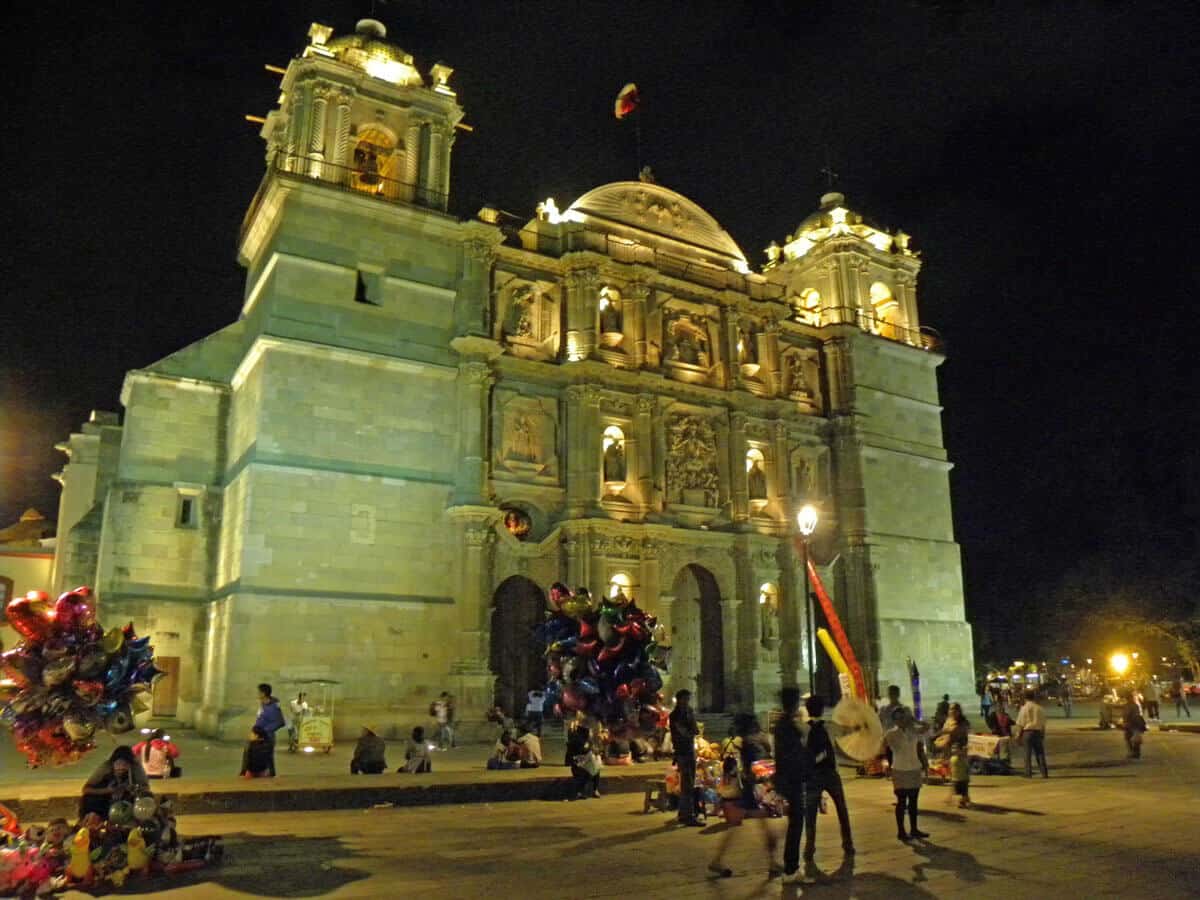
.
What I didn’t like in Oaxaca
I have issues with the poverty in Oaxaca. Our first night, walking past Palacio de Gobierno on the Zocalo, we saw about a hundred people sleeping on large pieces of cardboard. And despite the festive air of the main square, the music and crowds don’t cover the desperate looks of indigenous people and kids begging, selling junk (that few people would buy), or offering services (everything from shoe shines to sex). The shiny veneer of trendy bars and cafes, fancy restaurants, and well-dressed locals and tourists only barely camouflage the poverty of Oaxaca (one of Mexico’s poorest states).
Poverty won’t stop us from going anywhere. I’ve lived in Africa and travelled through much of the Caribbean and some of South America. And the poverty in Oaxaca doesn’t compare to the poverty I’ve seen in Colombia, Brazil, or the Dominican Republic. But there is always something disturbing about places with large disparities in income which gets to me.
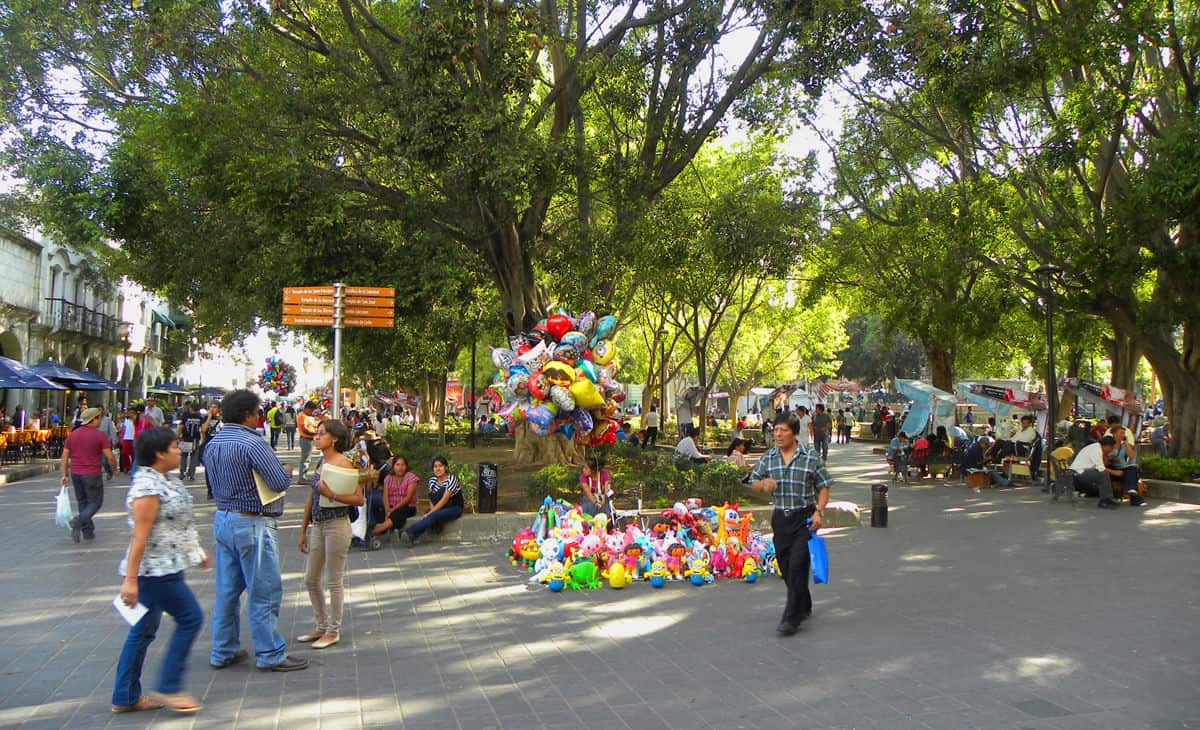
It wasn’t just the zocalo. Walk the alcala and you’ll always have someone beg for money or try to sell you something. Even on small side streets you’ll encounter an indigenous woman sitting on the ground, a couple of kids in her arms, a hand sticking out as she pleads for money. Right behind her they’ll be a nice restaurant or a fancy boutique store selling jewelry at inflated prices.
I know some of the comments I’ll get to the above. Travellers always get nasty comments whenever they have the gall to “complain” about poverty or begging. Let me make it clear that the begging we encountered in Oaxaca was not aggressive and that most of it came from women with children – not the aggressive youths I’ve encountered in other places. But as a traveller it always affects you. Some get angry and will wave away the beggars or just ignore them. Others feel a sense of shame and guilt and will give the beggars some change and a smile, knowing full well that their contribution will do diddly squat and will in fact just encourage begging. Either way, you come out of it liking the place a bit less, blaming either the beggars or the society that makes these people beg on the street in the first place.
And that’s why Oaxaca lost a bit of its shine with me.
*Note: I’ve had some people tell me that there must have been a protest and that the people sleeping in the square must have been protesters. Maybe, but we were there 5 days and never saw any protests going on.
Would I come back to Oaxaca? Yes. There is so much culture; great food, history, and art. We just scratched the surface of all there is to offer, not just in the city itself but in the surrounding state. I was here visiting my mom, who lives in Mexico. Anyone who’s read my other posts on Mexico knows that I’m a big fan of Mexico. I’m incredibly impressed with it as a travel destination, Oaxaca included. Would I ever consider settling in Oaxaca as an expat? No. For the reasons I’ve cited in the above paragraphs. My mom, who’s lived in Mexico almost 10 years, wouldn’t either.
November 2023 Update: A return to Oaxaca
Practical Information
– Accommodation. We stayed at Parador del Dominico which was excellent and well situated. Recommended.
– Organized Tours. Take a half day Tour of Oaxaca. If you have time, take this tour to see cultural and geographical highlights outside the city. The highlight of all attractions in Oaxaca (the one you can’t miss) is the Archeological site of Monte Alban.
– Flights. Oaxaca has flights to various parts of Mexico (Mexico City, Guadalajara, Huatulco, Queretaro…) as well as a few flights to the US (Houston, Dallas/Fort Worth).
Related: A roadtrip through Mexico’s most beautiful towns and cities (by bus)
Related: 11 Unforgettable Off-the-beaten path adventures in Mexico
Related: What’s it like living in Mexico? Observations and experiences of an American Expat
Ps. If you find our blog helpful, please consider using our links to book your flights, hotels, tours, and car rentals. Have a look at our Travel Resources page.

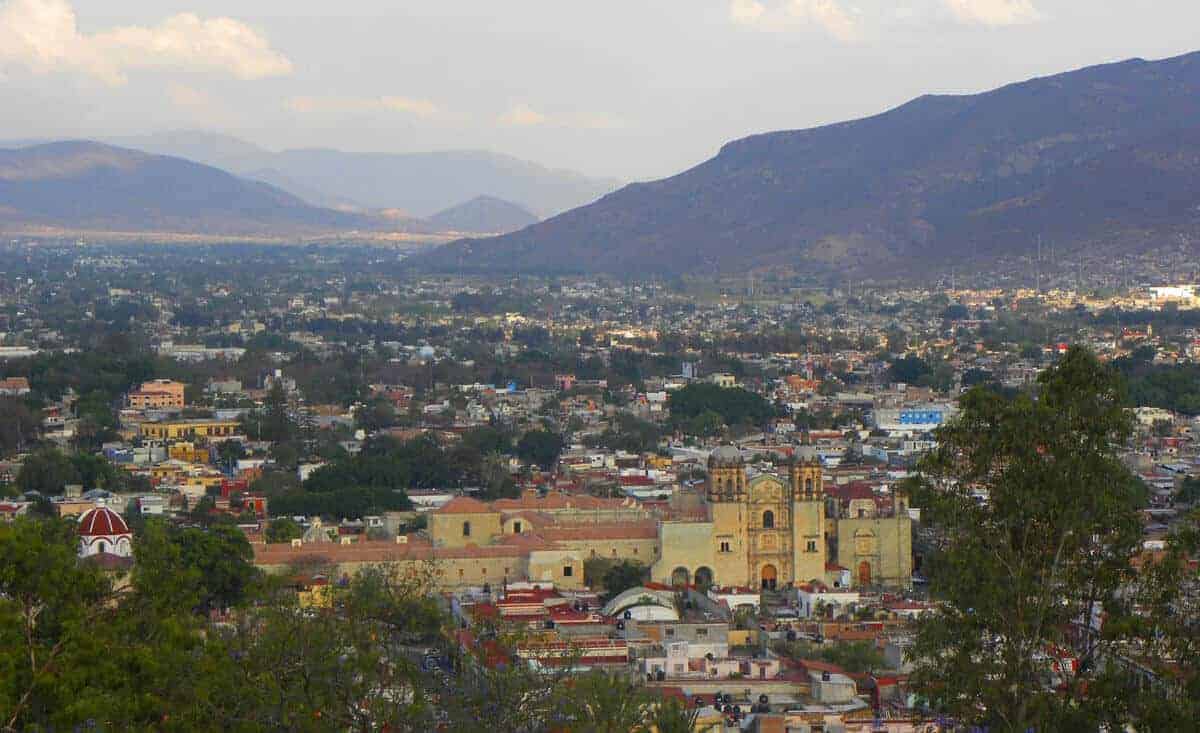
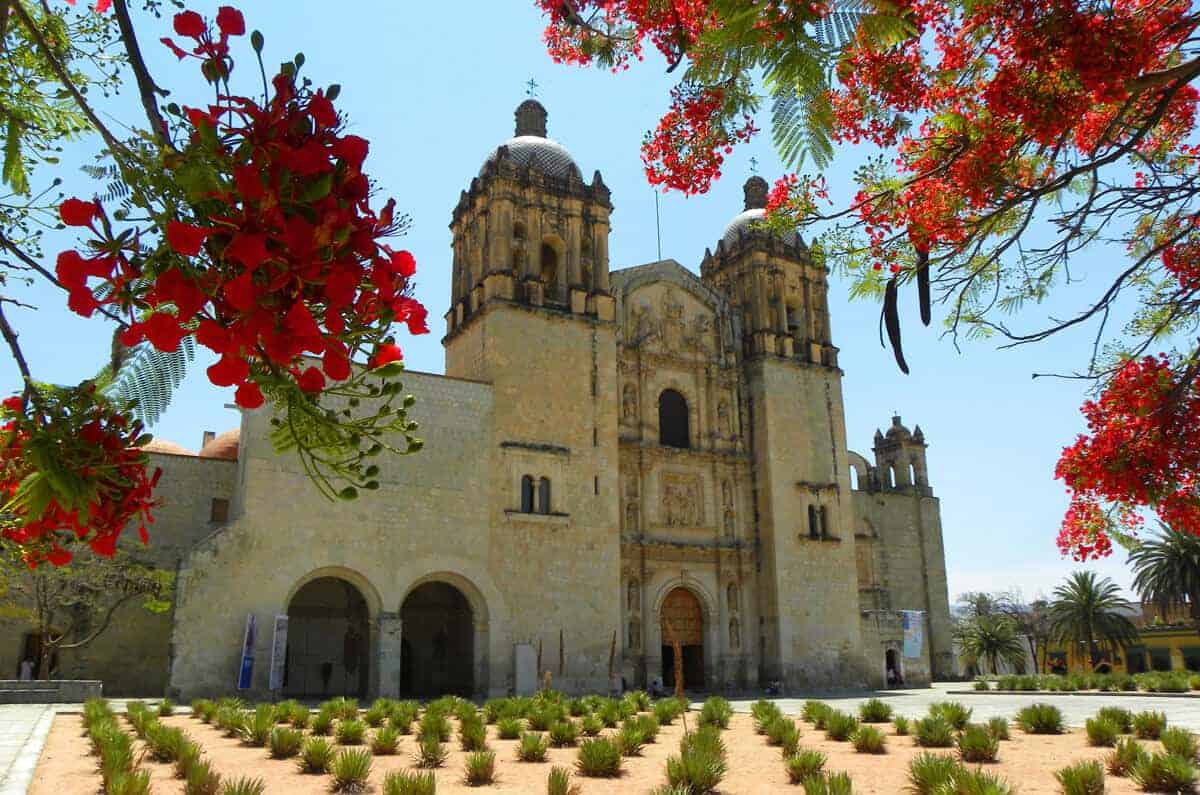
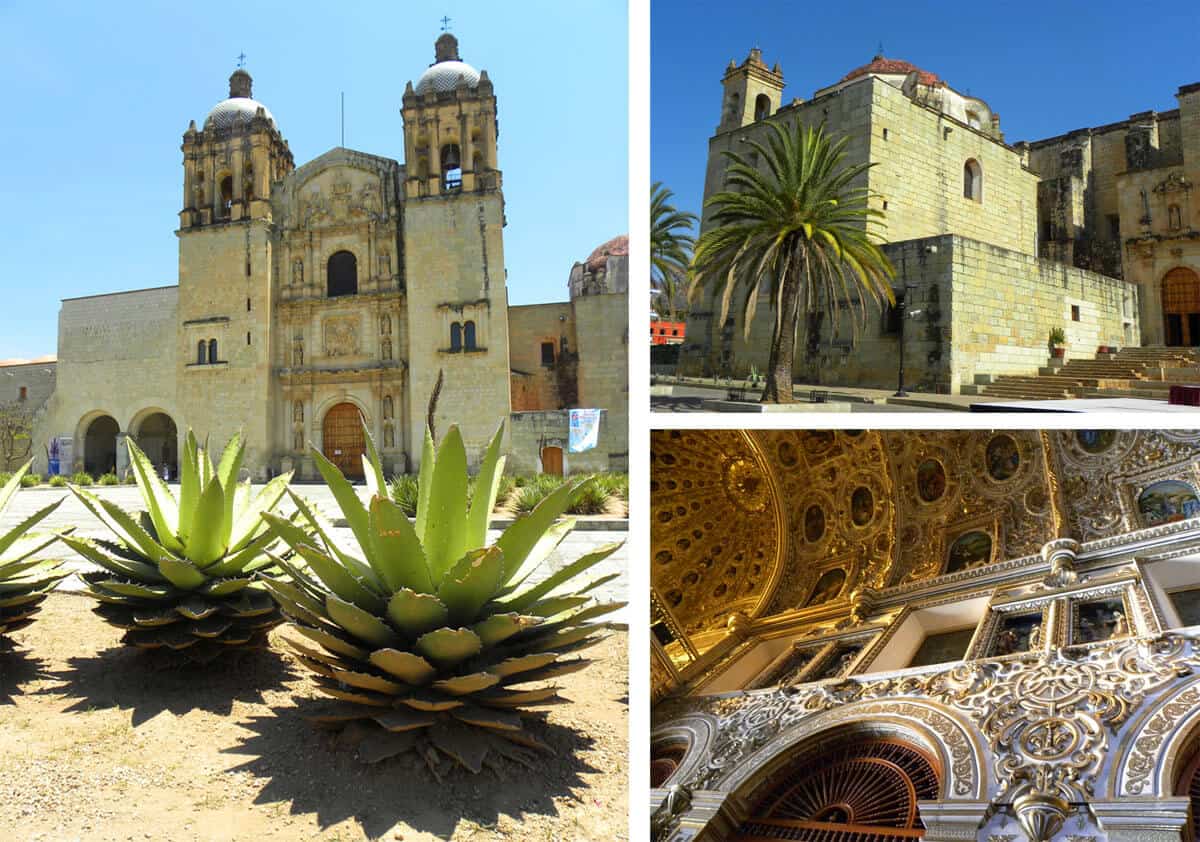

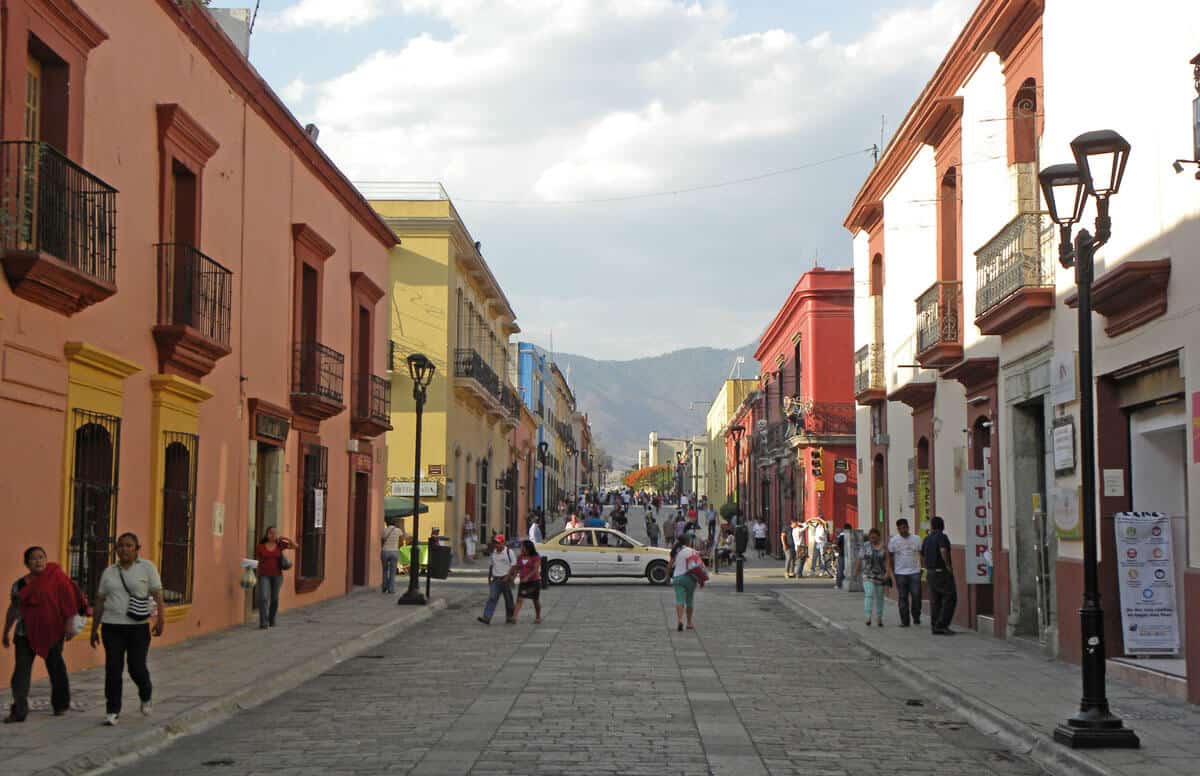

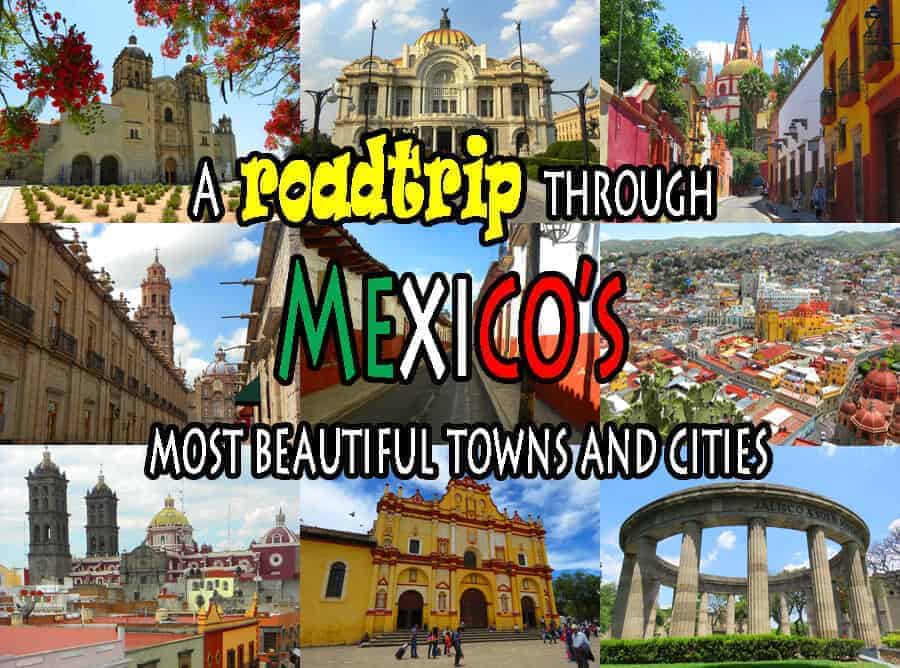


Interesting to read. I am fascinated to know about your travels and views. Yes I give people money, especially mothers with kids. How could I not?
Marianna
That’s good of you Marianne 🙂
I’ve lived in Mexico for 20 years, one month, and six days–first in San Miguel de Allende and now on the Pacific coast in Jalisco.I remember being horrified by the beggars in Calcutta, India, 50 years ago, but they don’t bother me here in Mexico. For one thing, due to the illiteracy rate in the southern states, few poor people know about the many government programs available for food, housing, and medical care. They are astounded when they ask me–a tall, blonde gringa–for money, and I gently explain their options in Spanish. (Of course, I give money to elderly women begging on the street.) Last summer, the Costalegre was such a blast furnace that I swore never to spend another summer here, so I’m looking for a cooler place to live from June through October. Oaxaca City is at the top of my list, which is why I closely follow relevant posts.
I think that a tourist’s point of view is often different from a resident’s. I have lived full-time in Mexico for 20 years and have witnessed begging in many forms. If a person is elderly, I tell him or her about the program that offers seniors a monthly stipend that is enough to live on. If I encounter a woman with children, I give her the address of the nearest DIF (family services) office and job training programs if she wants to work. If a person asks for money for health care, I remind him/her that public health clinics and hospitals are free. The southern states are poor mainly because the education system is terrible, in large part due to CNET, the radical teachers’ union. (But that’s another story altogether.) I get “targeted” often because I’m a tall, blonde gringa, so people are surprised when I share this kind of information in their own language. Begging doesn’t bother me because “siempre hay otra manera.” (There is always another way.)
In Oaxaca, there are several organizations to help the poor. One is Oaxaca Street Children Grassroots, which pairs people with means with kids who need their tuition paid, from tiny first-graders through college students. It’s an excellent way to offset all the feelings of grief and guilt associated with witnessing the poverty here. https://oaxacastreetchildren.org
Thank you very much for sharing that!
When I was in Oaxaca, there was a young indigenous woman sitting on a blanket outside my hotel everyday, from morning until dark. Dirty, and unkempt from living in the street, her toddler played next to her as her infant nursed at her breast. I would give her small change occasionally.
One day, I was out of small change and I gave her a large coin, after nearly thirty years, l can’t remember the value, but certainly more than I would normally give to a beggar in those days. Coming out of my hotel a short time later, I saw her feeding her toddler cut fruit from a plastic cup. I no longer doubt the need of people begging in the street. It gave real meaning to the expression, “living hand to mouth.”
I asked a local woman about the beggars in town. She dismissed them as “los flojos” or the lazy. I don’t know how that young woman wound up outside my hotel with her kids, but I’m pretty sure she would have done anything for a better way to live and feed her kids.
Great comment, thanks for taking the time. Something to remember.
I received your article and am planning a one-week vacation there. I live in the cruise port of Ensenada and there are aggressive beggars there. How could I handle the people you are talking about? I want to be kind, but I’m only there for 7 days and plan to pay for some sight-seeing tours.
Hi Grace. Nobody was ever aggressive, so you don’t have to worry about that. Depends on how you feel about begging, but maybe just keep a change bag handy for people you want to give to?
I say you should stay at your home where ever it is and help the American homeless. You don’t understand Mexican history and with the comments you made, you never will. Make sure your house is clean before writing about your neighbors.
I have been to the state of Oaxaca 10 times or more and I lived in Guadalajara for 15 years traveling to most major cities of Mexico. Oaxaca is one of the poorest states of Mexico. i am sorry to say there are more beggars on the streets of Houston, Texas.
I could go on making comparisons. Please try to find good points of others. Thnk you.
Not from the US, so you should inform yourself.
I’ve also done a lot of travelling in Mexico. Lived in Africa as well. What I’m saying is that I’ll never feel comfortable with the economic discrepancies that you see on the streets of certain cities. If you have no issues with it then that says more about you than it does about me.
Oaxaca itself is a nice city. Doesn’t take away from the negatives though (and yes, I know it’s one of the poorest states in Mexico. But not everyone knows the reality which is why I point it out).
I appreciate your handling of both the beauty and the realities of poverty in Oaxaca. I sometimes feel pressure there to spend spend spend and that I am looked at as “money”, especially in Oaxaca City itself. But on the other hand, I am in such awe of the culture and the people, I try to honor them and support where I can. I can’t even imagine going to Mexico and staying in a resort or a town where I would not be able to meet the locals. When in Oaxaca, I stay in a small apartment run by a local family , thus helping them and they help me in return. I take in all of the amazing art, e.g, the Textile museum, the Studio Xaquixe glass factory, the weavers in Teotitlan. I learned to weave rugs from a Zapotec master weaver, another mutual support activity. I support the Fundación En Vía, which is a micro financing organization that doesn’t charge interest to the women – they offer tours and you get to meet the applicants for the loans. I brought some supplies for a health clinic the last time I traveled there – suction catheters for newborns for a local midwife . I think it’s important that we visit not only for our support of the people there – but because of what they offer us as well – I find Zapotec people to be the kindest I have met anywhere and my life is richer for it… And then there is the food and Mezcal!
Great comment, its nice that you integrated yourself so well in the community and that you were so charitable. It sounds like a great experience and more people (including myself) should travel like that. Thanks so much Claudia for taking the time to comment while giving people ideas on how they can help out.
Great report on Oaxaca! Went to Jamaica and stayed in small local hotels and Cabana’s. The poverty was striking and since it was low season we were one of only a few tourists. We could not possibly help everyone enough. In Puerto Vallarta we were just part of a massive crowd of tourists. We gave to a few beggars, purchased things from others but it was not overwhelming there because opportunities to sell things are more abundant there.
I have to be rational about it. There is poverty everywhere. The monetary system makes the rich richer and the poor poorer and more numerous. I have spent years in poverty myself and I cannot pull all of the poor up with me even if I become poor in doing so. I spend what I have carefully and try to reward people who deserve it. Without tourists these places would be much poorer.
Most of what we spend traveling is airfare and accommodation. Not much of the airfare trickles down and the money spent on a place to stay could go to a realestate speculator or a local family. I prefer smaller hotels and guesthouses myself. I think the uncomfortable
feelings are one reason that all inclusives are so popular. Just stay in your resort most of the time and obscene wealth gaps won’t bother you so much.
Thanks Rene, all very true. We are the same, much prefer to stay in small family owed hotels and guesthouses, helps the locals but also gives you the opportunity to meet real people. Thanks for taking the time to comment, appreciate your thoughts.
Thanks for the honesty and I’m glad we’re not the only ones that felt let down by Oaxaca City. Poverty is very hard to deal with, we’re in Guatemala now and are helping out where we can. The best way we’ve found to do that is to purchase items from great projects that help out the locals and that give back to the community. Or, a restaurant/hostel that is run by locals (giving them jobs), which tend to have great programs in place as well. There are lots of excellent community programs on Lake Atitlan, which I’m really happy to see.
Cheers!
I’ll be following your posts in Lake Atitlan, it’s a place we’d both like to see and that we’ve heard good things about. We’ve done the same in Nicaragua, trying to stay at non-profit hotels where money is funneled back in the community.
Happy travels!
I’ve been wanting to spend a few months in Mexico, just learning the language and the culture. I think after reading this and your last post, I’d love to go to Oaxaca, despite the poverty there. I’m already planning my trip for next May (a year is a long time to wait – my toes are already itchy!) as a sort of graduation present to myself. I want to spend about two months there, and then pop over to Cuba for a while because, well, I’m not supposed to 🙂
Thanks for sharing the good and the bad. It’s not often travel bloggers talk about what they didn’t like, they tend to just leave those posts out. It’s nice to see a good balance, and yet I’m still sold on Oaxaca!
Yes, I think you should go to Oaxaca! Make sure to see the sights outside the city. And if you’re going to Cuba don’t skip Trinidad!
Begging bothers me, especially when it is done everywhere, maybe ten times or more in a day. Get left with uneasy feeling.
Interesting to read your post. Poverty also affects me while traveling. And it’s curious to observe how I deal differently with it than my husband, who is from India and is used to see plenty of poor people all around (much more than in Oaxaca, that’s for sure). In the beginning, particularly in India, I used to feel bad, feel guilty that I am privileged and other people don’t have the same opportunities. I often cried, specially when kid beggars would approach me. Until my husband told me that by crying I am not changing anything. And that is true. Either you do something, or you don’t. Now I try to deal with it the best I can – sometimes giving food to beggars, some other times money and, more often than not, nothing. I never know when I am actually contributing to schemes and people being exploited (beggar mafias as a reality and, unfortunately, very common in India). I also don’t want kids to grow up thinking that is is a sustainable way of making a living. But I worry that, on the other hand, they’ll go to bed with their tummies empty. It sucks. I just don’t know how to deal with it. I’d help poor people in the places I live, as my husband’s family often does in India. Helping those that you can follow up with is probably the only way to contribute to a positive change. Help the immediate people in your community, by giving them jobs or tasks… sharing whatever you can… help their kids going to school, etc. As a traveler I find it much more difficult to do something about it. It’s easy to give money but the impact that it can make it so limited in the bigger picture.
As for Oaxaca, I loved the 2 or 3 days I spent there a couple of years ago. The food, oh boy, that food!.. I should go visit your Mom one of these days! 😉
This is a great comment. I find it interesting how we view beggars in different cultures. India must certainly be hard-core when it comes to begging and I’m sure locals are to some degree immune to it. I’ll never forget going to Morocco, I was 16, and seeing begging lepers and blind people with bulging white eyes (not sure what they had) traumatized me. That’s going back 30 years and I’m sure Marrakesh has changed, but I’ll never forget that or how aggressive they were with their begging. Oaxaca is nothing compared to all that.
My mom not in Oaxaca, she just felt like going there for a look so we visited Puebla and Oaxaca on this trip. But it was her first experience with begging in Mexico and, although she finds Oaxaca interesting, was also put off by the economic disparities – enough that she wouldn’t call it home.
Thanks for the great comment Zara!
I didn’t see too much homelessness in Cancun really. You would get the occasional beggar but for the most part I would never see them and it wasn’t like we were living in the hotel zone. Maybe people in Cancun just hustle more, ton’s of folks slanging tamales, pan dulces, and other foods & services. There is a slum on the north side of the city, though I’ve never visited.